|
The Skinny on… Root Vegetables
These winter workhorses are always in season.
Article By: Bruce Weinstein and Mark Scarbrough
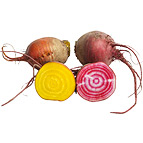 Beets
Although most of us know the dark-red “Detroit” beets, sweet beets actually come in many colors: yellow, gold, white and even peppermint-striped! Don’t want stained hands? Try yellow or golden beets — just as sweet but without the natural dye that turns everything red. Separate beet greens from the roots for storage. The greens will last a few days in the fridge; the roots, several weeks in your crisper or up to several months in a dry, cool, dark place like a root cellar. You can steam beets until tender, but they really come into their own when roasted.
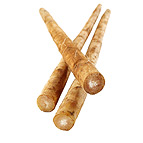 Burdock
This Asian root is the yellow, crunchy “pickle” common in sushi rolls. But it needn’t just be used as a garnish. Use sweet and earthy burdock as they do in Japanese cooking: sliced into thin coins and added to braises, sautés or stir-fries. It’s not starchy – more like an earthier, creamier water chestnut. The “skin” can be dirty, even sandy, so peel it off before using. However, peeled burdock will discolor quickly when exposed to the air, so keep a bowl of acidulated water on hand for storing slices until you’re ready to drop them in a pot or pan.
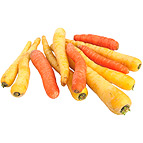 Carrots
There are many different kinds of carrots: Thumbelina carrots that look like little yellow golf balls; purple carrots, sometimes with an orange core and a less sweet taste; and even white carrots, quite mild and delicious. All can be eaten raw or cooked. If the carrots are going in a long braise, there’s really no need to peel them — just wash them to remove any dirt or grit before dicing or chopping. By the way, most bagged "baby" carrots are not immature carrots but instead pieces of large carrots whittled down to a size to fit toddler hands. Actual baby carrots are supersweet, great in salads.
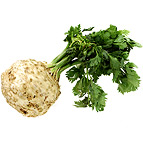 Celeriac
Also called “celery root” or “knob celery,” this European favorite has been grown over the centuries to create a large, globular root with distinct peppery, anise and starchy notes. It can be used almost any way a potato can: mashed, fried, steamed or stewed. However, it can also be eaten raw. Peeling these big roots can be a chore — you need to get down into the crevasses to take out the hairy roots. Best to use a small knife, not a vegetable peeler.
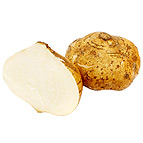 Jicama
Once the indigestible peel has been removed, jicama is ready to be eaten raw — and is highly prized for its distinct, watery crunch and its very mild, sweet flavor. Who can turn it down in tacos, wraps, salads and slaws? And don’t just think “raw.” You can cook jicama: Stir-fry it, sauté it, or even steam and mash it like potatoes. After cooking, jicama tastes like a starchy apple, sweet and irresistible.
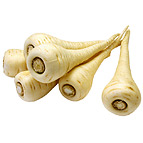 Parsnip
It looks like a carrot; it tastes like an herbaceous, perfumed sweet potato; and there’s nothing quite like it. Roasted, fried, mashed or braised, parsnips add a distinct pop to winter dishes. Although there are several varieties, they’re indistinguishable in the supermarket. Rarely eaten raw, parsnips should be peeled before cooking. And don’t wash them before storing; instead, wrap them in paper towels, put the bundle in a plastic bag, and store in the vegetable crisper for several months.
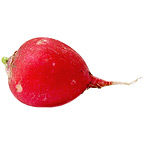 Radish
Radishes come in so many varieties: red, purple, orange, white. Breakfast radishes — so named because they pair so well with butter spread on bread — are long “fingerling” radishes with a soft flavor, gentle fire and delicate crunch. Here’s a culinary rule: the hotter the weather outside, the hotter the radish. Did you know that red radishes can also be cooked? Slice them, then braise in a little wine or stock — the flavor mellows considerably as the radishes soften.
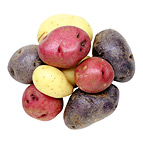 Potato
While you may know about red-skinned or yellow-fleshed potatoes, did you know that purple (or blue) potatoes are most closely related to the original varieties, grown high in the Andes? As a general rule, red-skinned potatoes are waxy; yellow-fleshed are creamy and buttery; blue potatoes are a bit starchier and sometimes sweeter; and baking potatoes like russets are very starchy, prized for their fluffy texture. Fingerlings can be roasted or steamed, then cut into thick coins and tossed into salads for a satisfying earthiness among the other raw veggies. 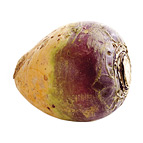 Rutabaga
Also called a “Swede” or a “wax turnip,” this Scandinavian favorite is sometimes waxed for long storage to seal in moisture. Once peeled, rutabagas can be shredded and eaten raw in salads or cut into wedges for braises, stews or roasts. Once cooked, they can even be mashed like potatoes. Choose rutabagas that are heavy to the hand; store them in a cool, dark place for a month or so. They’re a great substitute for turnips in recipes — not as spicy, a little sweeter, probably a better match for the kids at your table.
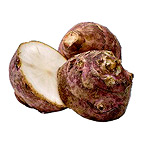 Sunchoke
Also called a “Jerusalem artichoke,” this starchy vegetable is actually indigenous to North America and directly related to the sunflower. The skin is edible — provided it is thin and tender. Sunchokes can be eaten raw, shredded or diced in salads, used as a vehicle for full-flavored dips, or cooked any way you’d cook a potato. The taste is nutty and mild — with a great crunch when raw, a gentle creaminess when cooked. One note: Sunchokes are notorious for causing gastric distress in some people. Go easy until you know your tolerance.
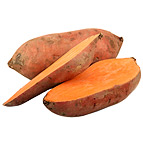 Sweet Potato
Don’t just think orange. Think purple, too. And white. These are all supersweet vegetables, related to ginger and grown in tropical climates. Sweet potatoes grown in the American South are sometimes sold as “yams.” But a true yam is a starchy, edible root from a Caribbean plant, sometimes imported into the United States. It’s usually white inside with a rough, dark skin. That’s a long way from the sweet potatoes we enjoy at the holidays. But expand your table and try them all!
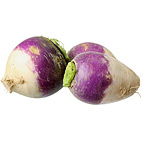 Turnip
These are maligned vegetables, mostly because they become more peppery and astringent the longer they sit in the root cellar. Within a few weeks of picking, small turnips are sweet and spicy, easily shredded raw into salads. Older, larger turnips should be peeled and diced for braises, stews, sautés and stir-fries. That peppery, radish-like flavor is best paired with something sweet in the mix like shredded apples, cabbage or zucchini.
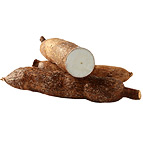 Yucca
Also called cassava, manioc or sometimes tapioca, this starchy, chewy, mildly sweet root vegetable can be found in almost all Latin-American markets as well as many large supermarkets. Yucca can be boiled, baked, steamed or mashed, about like a potato. Always peel the root before using it. The dry texture pairs well with creamy sauces. Yucca is highly perishable and should not be stored in your crisper for more than one week.
|